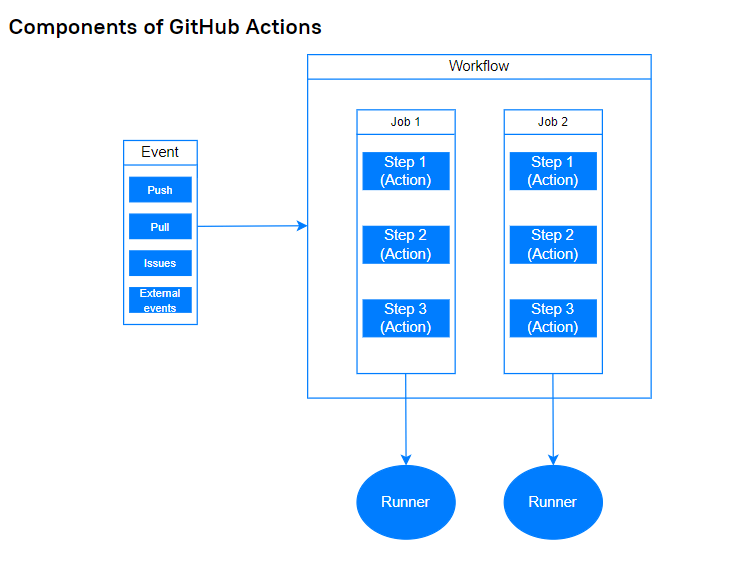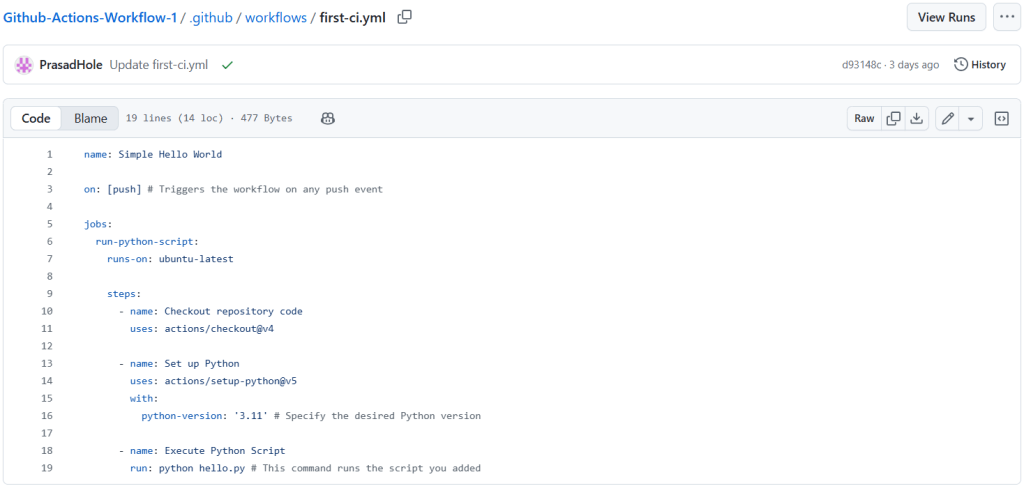In this article, we will thoroughly explore GitHub Actions, a powerful and fully integrated Continuous Integration/Continuous Delivery (CI/CD) and workflow automation platform provided by GitHub. We will delve into its architecture, core concepts, and practical applications, providing a detailed understanding of how developers can leverage it to automate, test, and deploy their software directly from their repositories.
Table of Contents
Understanding GitHub Actions and Its Purpose
GitHub Actions fundamentally serves as an event-driven automation engine residing within the GitHub ecosystem. Unlike external CI/CD tools that require separate integration or proprietary infrastructure, GitHub Actions allows developers to define complex automated workflows using standard YAML files placed directly in their repository. These workflows are designed to execute in response to specific events, such as pushing code, creating a pull request, or publishing a release.
The primary purpose of GitHub Actions is to automate the entire software development life cycle (SDLC), streamlining repetitive and time-consuming tasks. This includes essential practices like building and testing code (Continuous Integration), deploying applications to various environments (Continuous Delivery/Deployment), managing issue labels, running security scans, and automatically generating documentation. By consolidating these tasks, GitHub Actions helps enforce quality, reduce manual errors, and accelerate the time-to-market for software products.
Core Components of GitHub Actions
A successful understanding of GitHub Actions relies on grasping the purpose and interaction of its core building blocks, which are orchestrated within a specific directory structure in the repository: .github/workflows/.

1. Workflow
The Workflow is the highest level of abstraction. It is a defined automated process, typically stored as a YAML file. A single repository can host multiple workflows, each tailored to a different purpose (e.g., a “Test Workflow” and a “Deployment Workflow”). A workflow is activated by a defined Event.
2. Event
An Event is the specific activity that triggers a workflow execution. GitHub provides a rich set of built-in events, including: push (code pushed to a branch), pull_request (PR opened or updated), schedule (runs at specified times), and workflow_dispatch (manual execution via UI/API).
3. Job
A Job is a set of defined sequential steps that execute on a single Runner. A workflow must contain at least one job. Multiple jobs within a workflow run concurrently by default, but dependencies can be managed using the needs: keyword.
4. Step and Action
A Step is an individual task within a job. A step can execute a simple shell command (e.g., run: npm install) or run an Action. An Action is the smallest and most portable building block—a reusable, pre-packaged unit of code that performs a specific task, such as actions/checkout@v4 to retrieve code.
5. Secrets and Artifacts
Artifacts: Files or directories produced by a job (like a compiled binary or test logs) that are uploaded, stored by GitHub, and can be downloaded by other jobs or users, essential for preserving build outputs.
Secrets: Encrypted environment variables stored in GitHub that allow workflows to securely access sensitive information like API keys or credentials without exposing them in the workflow file.
Architecture of GitHub Actions
The architecture describes how the components interact and where the processing takes place to execute an automation workflow.
1. Workflow Definition and Triggering
The process begins when a defined Event occurs in the repository (e.g., a code push). This event is detected by the GitHub Actions service, which looks for a corresponding YAML Workflow file in the .github/workflows/ directory.
2. Runner Provisioning
Upon a trigger, GitHub provisions a dedicated execution environment called a Runner.
- GitHub-hosted runners: These are virtual machines (Linux, Windows, or macOS) that are automatically managed, ephemeral (destroyed after the job completes), and provisioned on demand by GitHub.
- Self-hosted runners: These are servers or machines set up by the user, offering complete control over the execution environment, often used for specific hardware needs or private network access.
3. Job Execution and Orchestration
The workflow’s Jobs are assigned to the provisioned runner(s). The Runner downloads the job definition and begins executing the Steps sequentially. If multiple jobs are defined without dependencies, they run on separate runners concurrently. The state of the entire workflow (success/failure) is reported back to the GitHub Actions service and displayed in the GitHub UI.
A CI/CD Workflow Example
We will create a workflow to execute python script which will return a simple “Hello World” message. This workflow will be triggered on every push and pull request to the main branch, ensuring that the code always builds and passes all tests before it can be merged.
First write a python script hello.py in the root of your repository.
import platform
print("Hello World")
print(f"Python version: {platform.python_version()}")
Create the workflow file inside the .github/workflows directory.
CI Workflow File (.github/workflows/first-ci.yml)
name: Simple Hello World
on: [push] # Triggers the workflow on any push event
jobs:
run-python-script:
runs-on: ubuntu-latest
steps:
- name: Checkout repository code
uses: actions/checkout@v4
- name: Set up Python
uses: actions/setup-python@v5
with:
python-version: '3.11' # Specify the desired Python version
- name: Execute Python Script
run: python hello.py # This command runs the script you added
YAML Section Explanation
name: Simple Hello World: This is the human-readable name for your workflow that appears in the repository’s CI/CD interface.on: [...]: This defines the trigger events for the workflow- It specifies that the workflow runs when code is pushed or a pull request is opened/updated, but only if the action involves the
mainbranch.
- It specifies that the workflow runs when code is pushed or a pull request is opened/updated, but only if the action involves the
jobs:A workflow can contain one or more jobs. This is the collection of all tasks to be executed.run-python-script:This is the ID (unique identifier) for a single job within the workflow.runs-on: ubuntu-latest: This specifies the environment (virtual machine) where the job will execute. Here, it uses the latest version of the Ubuntu operating system.steps:This is a sequential list of tasks that the job will perform.- name: Checkout repository code: This step uses the officialactions/checkout@v4action to download (clone) your repository’s code onto the runner machine so the job can access yourhello.pyfile.- name: Set up Python: This step uses the officialactions/setup-python@v5action.- It ensures that the specified version of Python (
3.11) is installed and configured on the runner machine.
- It ensures that the specified version of Python (
- name: Execute Python Script: This is the core task.- The
run:keyword executes a shell command (python hello.py) directly on the runner machine, which prints the “Hello World” message.
- The
Continuous Deployment & Orchestration
These articles focus on deploying applications to various environments and integrating with orchestration tools like Kubernetes and ArgoCD.
- Deploy to Kubernetes using GitHub Actions CI/CD, Docker, DockerHub and ArgoCD
- Deploy Spring Boot App on Kubernetes with ArgoCD and GitHub Actions
- Deploy NodeJS App Helm Chart on Minikube using GitHub Actions and ArgoCD
- Deploy nodejs Helm chart on EKS using GitHub Actions [2 Steps]
- Deploy nodejs app to EKS using GitHub Actions
- How to Deploy to Minikube using GitHub Actions
Cloud & Serverless Deployment
These articles cover deployment to specific cloud environments and using serverless frameworks.
Containerization & Registry Management
These articles focus on the initial steps of the CI/CD pipeline: building Docker images and pushing them to container registries.
- Build & Push Docker Image to DockerHub Using GitHub Actions
- Build and Push Docker Image to AWS ECR Using GitHub Actions
GitOps & Advanced Workflow
These articles cover the advanced pattern of managing infrastructure and application state using Git as the single source of truth.
Interview Preparation
This is a specific category dedicated to assessment and knowledge checking.
Conclusion
GitHub Actions is an indispensable tool for modern software teams, providing a robust and flexible framework for automating all aspects of the development pipeline. By mastering the core concepts—Workflows, Events, Jobs, Steps, Actions, Runners, Secrets, and Artifacts—developers can create highly efficient, version-controlled, and secure CI/CD pipelines directly within their GitHub repositories.
Related Articles:
Top 40 GitHub Actions Interview Questions and Answers
Reference:
